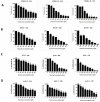Piperine causes G1 phase cell cycle arrest and apoptosis in melanoma cells through checkpoint kinase-1 activation
- PMID: 24804719
- PMCID: PMC4013113
- DOI: 10.1371/journal.pone.0094298
Piperine causes G1 phase cell cycle arrest and apoptosis in melanoma cells through checkpoint kinase-1 activation
Abstract
In this study, we determined the cytotoxic effects of piperine, a major constituent of black and long pepper in melanoma cells. Piperine treatment inhibited the growth of SK MEL 28 and B16 F0 cells in a dose and time-dependent manner. The growth inhibitory effects of piperine were mediated by cell cycle arrest of both the cell lines in G1 phase. The G1 arrest by piperine correlated with the down-regulation of cyclin D1 and induction of p21. Furthermore, this growth arrest by piperine treatment was associated with DNA damage as indicated by phosphorylation of H2AX at Ser139, activation of ataxia telangiectasia and rad3-related protein (ATR) and checkpoint kinase 1 (Chk1). Pretreatment with AZD 7762, a Chk1 inhibitor not only abrogated the activation of Chk1 but also piperine mediated G1 arrest. Similarly, transfection of cells with Chk1 siRNA completely protected the cells from G1 arrest induced by piperine. Piperine treatment caused down-regulation of E2F1 and phosphorylation of retinoblastoma protein (Rb). Apoptosis induced by piperine was associated with down-regulation of XIAP, Bid (full length) and cleavage of Caspase-3 and PARP. Furthermore, our results showed that piperine treatment generated ROS in melanoma cells. Blocking ROS by tiron protected the cells from piperine mediated cell cycle arrest and apoptosis. These results suggest that piperine mediated ROS played a critical role in inducing DNA damage and activation of Chk1 leading to G1 cell cycle arrest and apoptosis.
Conflict of interest statement
Figures






Similar articles
-
Piperine, an alkaloid from black pepper, inhibits growth of human colon cancer cells via G1 arrest and apoptosis triggered by endoplasmic reticulum stress.Mol Carcinog. 2015 Oct;54(10):1070-85. doi: 10.1002/mc.22176. Epub 2014 May 13. Mol Carcinog. 2015. PMID: 24819444
-
Chk1 and Wee1 control genotoxic-stress induced G2-M arrest in melanoma cells.Cell Signal. 2015 May;27(5):951-60. doi: 10.1016/j.cellsig.2015.01.020. Epub 2015 Feb 12. Cell Signal. 2015. PMID: 25683911
-
Piperine induces apoptosis of lung cancer A549 cells via p53-dependent mitochondrial signaling pathway.Tumour Biol. 2014 Apr;35(4):3305-10. doi: 10.1007/s13277-013-1433-4. Epub 2013 Nov 24. Tumour Biol. 2014. PMID: 24272201
-
Piper nigrum and piperine: an update.Phytother Res. 2013 Aug;27(8):1121-30. doi: 10.1002/ptr.4972. Epub 2013 Apr 29. Phytother Res. 2013. PMID: 23625885 Review.
-
Black pepper and its pungent principle-piperine: a review of diverse physiological effects.Crit Rev Food Sci Nutr. 2007;47(8):735-48. doi: 10.1080/10408390601062054. Crit Rev Food Sci Nutr. 2007. PMID: 17987447 Review.
Cited by
-
Research Trend and Detailed Insights into the Molecular Mechanisms of Food Bioactive Compounds against Cancer: A Comprehensive Review with Special Emphasis on Probiotics.Cancers (Basel). 2022 Nov 8;14(22):5482. doi: 10.3390/cancers14225482. Cancers (Basel). 2022. PMID: 36428575 Free PMC article. Review.
-
Piperine Inhibits TGF-β Signaling Pathways and Disrupts EMT-Related Events in Human Lung Adenocarcinoma Cells.Medicines (Basel). 2020 Apr 8;7(4):19. doi: 10.3390/medicines7040019. Medicines (Basel). 2020. PMID: 32276474 Free PMC article.
-
Magnolol pretreatment attenuates heat stress-induced IEC-6 cell injury.J Zhejiang Univ Sci B. 2016 Jun;17(6):413-24. doi: 10.1631/jzus.B1500261. J Zhejiang Univ Sci B. 2016. PMID: 27256675 Free PMC article.
-
Sesquiterpene Lactones Potentiate Olaparib-Induced DNA Damage in p53 Wildtype Cancer Cells.Int J Mol Sci. 2022 Jan 20;23(3):1116. doi: 10.3390/ijms23031116. Int J Mol Sci. 2022. PMID: 35163037 Free PMC article.
-
Phytochemicals as Immunomodulatory Agents in Melanoma.Int J Mol Sci. 2023 Jan 31;24(3):2657. doi: 10.3390/ijms24032657. Int J Mol Sci. 2023. PMID: 36768978 Free PMC article. Review.
References
-
- Markovic SN, Erickson LA, Flotte TJ, Kottschade LA, McWilliams RR, et al. (2009) Metastatic malignant melanoma. G Ital Dermatol Venereol 144: 1–26. - PubMed
-
- Wellbrock C, Karasarides, Marais R (2004) The RAF proteins take centre stage. Nat Rev Mol Cell Biol 5: 875–885. - PubMed
-
- Gray-Schopfer V, Wellbrock C, Marais R (2007) Melanoma biology and new targeted therapy. Nature 445: 851–857. - PubMed
-
- Bartkova J, Lukas J, Guldberg P, Alsner J, Kirkin AF, et al. (1996) The p16-cyclin D/Cdk4-pRb pathway as a functional unit frequently altered in melanoma pathogenesis. Cancer Res 56: 5475–5483. - PubMed
-
- von Willebrand M, Zacksenhaus E, Cheng E, Glazer P, Halaban R (2003) The tyrphostin AG1024 accelerates the degradation of phosphorylated forms of retinoblastoma protein (pRb) and restores pRb tumor suppressive function in melanoma cells. Cancer Res 63: 1420–1429. - PubMed
Publication types
MeSH terms
Substances
Grants and funding
LinkOut - more resources
Full Text Sources
Other Literature Sources
Molecular Biology Databases
Research Materials
Miscellaneous

